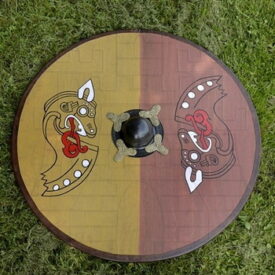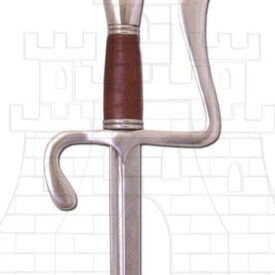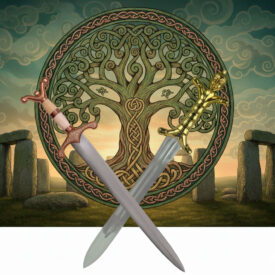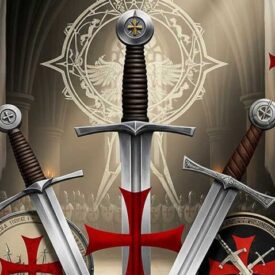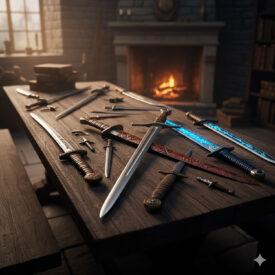A sword can tell the story of an era. With its basket-shaped hilt, these blades that embrace the warrior’s hand not only defended against enemy steel: they embodied prestige, technique, and an ingenious response to organized violence on the battlefield.

A Hook for the Imagination
What would it feel like to wield a sword whose hilt envelops your hand like a protective cage? That sensation mixes security and power. Since the 16th century, the basket-hilted sword earned its place in warfare, in the escort of officers, and in the iconography of military honor.
In this article, you will learn to recognize its essential features, understand its historical evolution, identify the most significant variants, and appreciate why it remains an object of study, practice, and collecting among enthusiasts and historical reenactors.
History and Evolution of Basket-Hilted Swords
| Date | Event |
|---|---|
| 1545 | Recovery of one of the first basket-hilted swords from the wreck of the Mary Rose, confirming its use in the 16th century; before this discovery, the oldest dated pieces were from the English Civil War. |
| 16th Century | Initial appearance and popularization of the basket hilt. Simple wire guards and the basic basket design were already being consolidated; swords were generally for cutting and thrusting. It is probable that Spanish conquistadors brought this type of weapon to Chile during the early years of the Arauco War. The rapier and schiavona also began to use basket hilts in the Renaissance. |
| 17th Century (beginning and development) | The design of the basket-hilted sword gains popularity and becomes widespread in Europe; regional variations emerge (Walloon, Sinclair, schiavona, mortuary, Scottish broadsword). It is recommended that the grip facilitates handling and prevents the sword from slipping or falling. |
| After 1625 | Use of the mortuary sword by cavalry during the English Civil War; cutting and thrusting weapons often double-edged with highly ornamented half-basket hilts. |
| 1649 (after) | After the execution of Charles I, basket-hilted swords are manufactured with hilts depicting the face or death mask of the “martyr king.” |
| Until approximately 1670 | Mortuary swords remained in use until around 1670, when they began to be replaced by the smallsword among civilians. |
| 1672 | France adopts the Walloon sword as its first regulation sword after campaigns in the Netherlands. |
| Late 17th and early 18th Century | The Scottish broadsword with a basket hilt (claymore/claidheamh mór) is common among clan members in the Jacobite rebellions. |
| 1746 | The design of basket-hilted swords is fully established; many regional variants exist in northern England and Scotland. A version from the Battlecry collection is inspired by a design that might have been seen at the Battle of Culloden. |
| Throughout the 18th Century | Widespread use of the basket-hilted sword, especially in heavy cavalry, until the Napoleonic era. In Europe, regulation dress swords (e.g., the French model) become essential accessories for officer attire. |
| 19th Century | The term “Sinclair hilt” is applied by Victorian antiquarians to Scandinavian swords resembling Scottish ones from the 17th–18th centuries; antiquarian interest in these variants consolidates. |
| Summary: Basket-hilted swords emerged in the 16th century, reached their greatest popularity and diversification in the 17th–18th centuries, being used by heavy cavalry and nobility; their basic design endures in military parade swords to this day. | |
Anatomy of the Guard: What it Protects and How it Works
The purpose of the basket is simple yet brilliant: to protect the hand without sacrificing mobility. The metal structure surrounds the hilt, preventing cuts, direct blows, and pinches in hand-to-hand combat.

Parts You Need to Know
- Pommel: counterweight and finishing piece that aids balance and secures the tang.
- Tang and Tang Button: internal element that passes through the hilt and is secured with rivets or a screw in the pommel.
- Shell Guard: a piece in some designs that covers part of the hand and stabilizes the hilt.
- Ricasso: unsharpened section next to the guard that allows for a forward grip.
- Blade: variations in width, thickness, and point depending on the function (cutting, thrusting, or mixed).
- Sword Knot (dragona): strap that connects the guard to the wrist; in some periods, it was functional, in others, a parade ornament.
Types and Families: From the Schiavona to the Scottish Broadsword
The category “basket-hilted sword” groups several regional solutions. Each design responds to a military context, combat technique, and the aesthetic taste of its era.
Schiavona
Of Italian origin, popular in the 17th century, the schiavona features a decorated and robust basket. It was prized by mercenaries and heavy cavalry for its resilience in shock.
Mortuary Sword
Known for its ornamented guards and use during the English Civil War, the mortuary sword combined cutting and thrusting capability with superior hand protection for the rider.
Broadsword or Scottish Broadsword
The Scottish variant is iconic: a wide blade, effective in cutting, with a guard that in many models becomes an identifying emblem. Associated with both military use and clan tradition.
Walloon and Sinclair
The Walloon sword was adopted by France in the 17th century as a regulation model after campaigns in the Netherlands. The Sinclair hilt, later cited by antiquarians, shows the transfer of forms between regions.
Replicas and Representative Models
Recreating a basket-hilted sword requires a balance between authenticity and functionality. Many modern replicas reproduce aesthetic details and historical proportions, incorporating contemporary materials that facilitate their conservation and use in controlled practices.
Here’s a technical example illustrating common proportions in full-size replicas:
- Overall Length: approximately 99 cm.
- Blade Length: around 83 cm.
- Average Weight: 1.1–1.6 kg depending on the style and steel.
- Hilt Length: 15–17 cm to allow for a one-handed grip and a half-forward grip.
- Blade Width: variable: 3 cm at the guard to 2 cm at the tip in cutting-thrusting models.
A practical example preserved in commercial records describes a sword with: length 99 cm, blade 83 cm, weight 1.16 kg, hilt 16.5 cm, center of gravity 8 cm, widths and thicknesses that facilitate both cutting and thrusting; manufacturing attributed to recognized replica brands.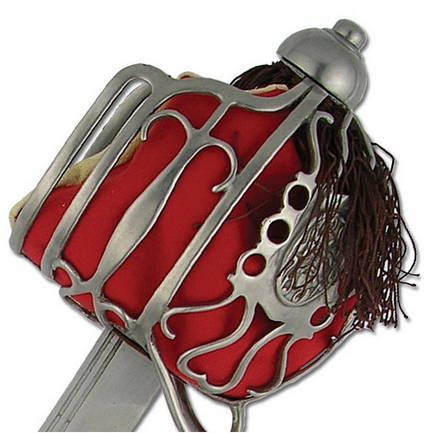
Materials and Forging: From Traditional Steel to Modern Alloys
The quality of the steel and the tempering process are crucial for a blade that will resist and maintain its edge. Historically, centers like Solingen, Toledo, and Saint-Étienne set standards of reputation for their resources and metal treatment techniques.
Today, replicas and functional blades typically use carbon steels (e.g., 1065) or steels with controlled heat treatments that achieve appropriate hardness for safe practice, balancing toughness and wear resistance.
Forging and Tempering
- Forging: welding and shaping the basic form, sometimes with rolling to homogenize the steel grain.
- Tempering: heating and cooling to obtain the desired combination of hardness and elasticity.
- Tempering (Revenido): a process that reduces internal stresses and prevents brittleness.
Traditional technique emphasizes an edge treatment that allows for efficient cuts without sacrificing impact absorption capability.
The Technique of Use: Fencing, Cavalry, and Close Combat
The basket-hilted sword is not just a visual trophy: its design facilitates precise maneuvers. The hand protection enhances the user’s confidence to execute cuts and thrusts with less risk of losing the weapon due to a lateral blow.
In cavalry, where contacts were abrupt and the palm was exposed, the basket proved its worth. In foot fencing, it allowed techniques that combine broad cuts and thrusts to the torso.
Handling Principles
- Balance: the weight distribution between blade and pommel defines the recovery speed.
- Forward Grip: using the ricasso for greater control in precise thrusts.
- Passive Protection: the basket absorbs impacts that would otherwise hit the hand on other hilts.
Maintenance, Preservation, and Safety
Maintaining a basket-hilted sword in good condition involves metal hygiene and hilt care. Although many replicas use stainless steels, preventive rust treatment and checking rivets and fastenings are essential for safety in practice.
- Cleaning: dry and oil the blade after use to prevent corrosion.
- Basket Inspection: check rivets and welds to avoid structural failures.
- Storage: avoid humidity and supports that deform the blade.
These cares prolong the life of the piece and maintain its epic and original aesthetic.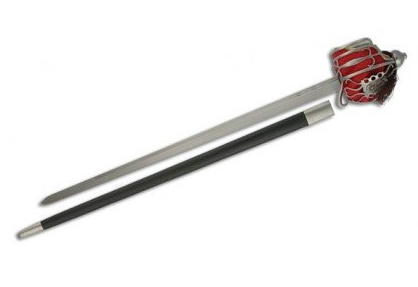
Iconography and Symbolism: The Sword as a Standard
Beyond its functionality, the basket-hilted sword became a symbol of rank and distinction. In military offices and formal wear, ornate guards represented status and belonging to a martial tradition.
In the Ibero-American tradition, many pieces circulated among officers illustrating the mix of European forms and local details; hilts, such as those with French or Prussian influence, speak of cultural and military itineraries that crossed oceans.
Historical Cases and Illustrious Owners
Some historical military figures are known for the type of weapons they carried; their swords evoke periods, battles, and leadership styles. Various period inventories feature dress swords and sabers with elaborate guards that accompanied officers in decisive campaigns.
Naval Variants and Guard Sabers
At sea and in confined spaces, protective guards also evolved. Models of naval sabers and cavalry sabers incorporated robust guards to prevent injuries in shipboard combat or during loading and unloading with close contact.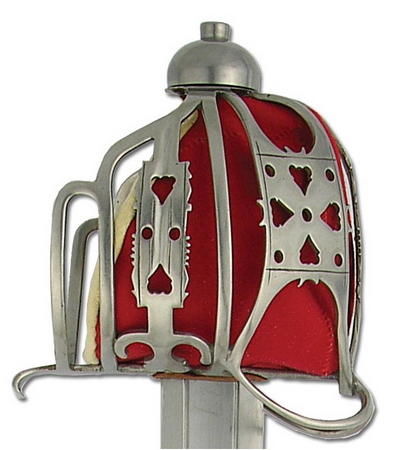
Why Are Basket-Hilted Swords of Interest Today?
There are several reasons why these weapons have regained prominence among enthusiasts: their powerful aesthetics, their efficiency in hand protection, and their link to historical fencing techniques. Furthermore, the historical practice and HEMA community finds in these pieces a tool for studying movements, distances, and realistic use of bladed weapons.
Current Trends
- Historical Reenactment: reenactors seek faithful replicas to represent specific periods.
- Functional Training: some practitioners use steel replicas to study technique.
- Contemporary Design: artisans combine aesthetic fidelity with material improvements for durability.
Technical Examples and Reference Notes
Technical descriptions included in commercial catalogs or manufacturer datasheets usually help identify the purpose of the piece: whether it is decorative, functional, or for practice. A typical datasheet may include measurements of length, weight, center of gravity, blade width, and thickness at different points, and the manufacturer or workshop indication.
The technical sheet circulating in commercial records mentions: Length 99 cm, Blade length 83 cm, Weight 1.16 kg, Hilt length 16.5 cm, Center of gravity 8 cm, Blade width (at guard) 3.18 cm, Blade width (at tip) 2.21 cm, Blade thickness (at Guard) 0.6 cm, Blade thickness (at tip) 0.25 cm, Manufacturer: CASS HANWEI (PAUL CHEN).
These data help to compare and understand how certain replicas seek to replicate the behavior of historical pieces without assuming the limitations of ancient material.
How to Integrate a Basket-Hilted Sword into a Collection or Practice
If you are looking for a piece for training or display, consider its function: will it be for practice, demonstration, or decoration? Each use requires different specifications in steel, treatment, and assembly.
- Practice: choose durable steel and blades with controlled tempering.
- Demonstration: balance between historical finish and safety.
- Decoration: greater aesthetic freedom, fewer functional demands.
Respect for the History and Art of the Sword
Wielding a basket-hilted sword is, for many, a bridge to the past. Whether you are attracted to its presence in a recreated battle scene or you value its form and proportions for study, there is always an ethical dimension: use the piece with respect and understand its historical context. This respect fuels the passion for preserving techniques, forges, and stories that have shaped these protective guards.
VIEW BASKET-HILTED SWORDS | VIEW OTHER SCOTTISH BASKET-HILTED SWORDS
The basket-hilted sword has been a technical response to a very human demand: to protect the hand in the struggle for survival, honor, and victory. Today, its presence reminds us that military design is often the synthesis of necessity, art, and symbol.

